
Penta Gram
Pentawards is an annual packaging design competition, and since 2021, they have started releasing an annual packaging Trends Report. Via Print magazine, the new edition is out.
With over 2,000 packaging design projects submitted each year from 60 countries, Pentawards is in a strong position to witness and share the trends as seen from a truly international point of view.
A couple that Print calls out:
Art of Subtle Details: In drinks packaging in particular, we’re seeing brands going the extra mile with subtle details to evoke a particular character or narrative around their products, creating a sense of depth, discovery, and personality. Packs featured include MIAO by Left and Right Creative Design, Carmenero by Spazio di Paolo, Cutthroat Gin by Mousegraphics

Layering up: Packaging is more than protection; it’s a canvas for storytelling, and here, we see that layers have been used to indicate transitional processes, stories and layers of ingredients. Packs featured include Clos du Val Bernard’s Cuvée by CF Napa Brand Design, As one with olive oil by Design Bridge & Partners, Terroir 41º N, 0º E by Vamos Estudio
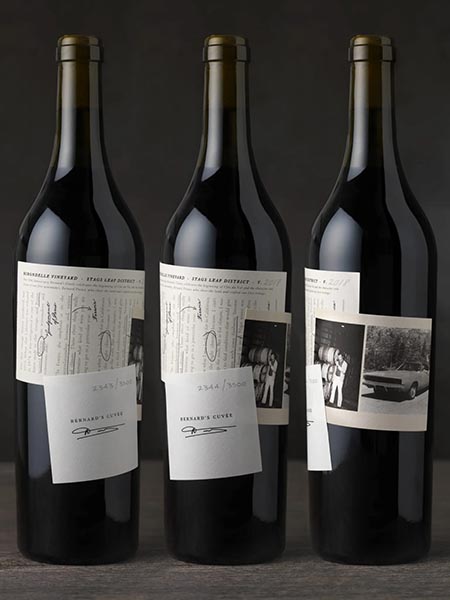
At any rate, click through to Print for a couple more examples. Download the report here. You can also check out Pentawards’ recently launched online Trend Talks. If you were looking to enter this year’s Pentawards, alas, the deadline was yesterday.
Can You Judge a Market By Its Cover?
Barry Ritholtz at The Big Picture takes a look at a unique magazine cover phenomenon: when a company appears on the cover of a popular magazine, what signals does it give the market? What triggered this discussion was a 2017 Barron’s cover.
The 2017 Barron’s cover…showing Apple’s extravagant new headquarters and suggesting that the company’s market value would reach $1 trillion in 2018 generated some chatter from the usual suspects. An issue like this touches on several previously debunked ideas. Let’s use this as an opportunity to discuss the significance of magazine covers and what they might mean for investors.
In other words, if a company is the subject of a splashy magazine cover, does that mean it is worth investing in? Or, conversely, worth avoiding, in that a company getting a prominent magazine cover is a contrarian signal to investors? There are several issues that Ritholtz identifies with regard to cover images.
Magazine Cover Indicator: Originally created by money manager Paul Macrae Montgomery, this remains a widely misunderstood market signal. The basic premise of the cover indicator is that of a contrary sign of societal sentiment, reflecting when an investment theme has reached a crescendo. Said more plainly, by the time the editors of mass-media publications find out about some hot new investing trend, it has reached every corner of society and is ripe to end.
Montgomery stipulated, among other things, that the magazine must be a mainstream one, not a financial or business periodical. Ritholtz points out, then:
there isn’t much of a contrarian signal in a financial weekly putting the largest market capitalization company on its cover.
Also, too:
Single Company Magazine Cover Indicator: Here is where people really go astray — any individual company on any cover generates little in the way of usable signal. I have discussed this repeatedly, but one graphic settles the argument. It is from Kuo Design, and it shows all 138 magazine covers that have Apple and/or co-founder Steve Jobs on the cover from 1981 until today.
Can you identify which of those 138 covers is the actual sell signal?
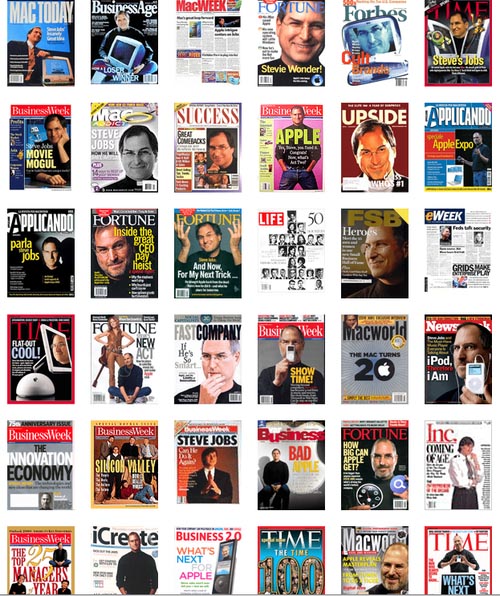
Yeah, me neither.
Ultimately, there is little being signaled by a magazine cover, at least for investors.
The bottom line about magazine covers is that maybe they can be helpful in identifying when a broad trend reaches a top; they are much less helpful in telling investors when to unload the shares of any particular company.
New Traditionalist
Mark Mothersbaugh is perhaps best known as the co-founder, composer, lead singer and keyboardist of Devo, who in turn is perhaps best known for the 1980 hit “Whip It” (although their first four albums are universally excellent). He has also done a fair amount of soundtrack composing for movies, TV, and video games. At any rate, via Print magazine, Mothersbaugh has a new book out.
Apotropaic Beatnik Graffiti (Blank Industries), published today, is a hypnotically hyper-visual collection of neo-Dada stream-of-conscious visual poetry, representing one human’s observations of “life on a sliding planet.” I had to look up the word apotropaic—and you should now do the same.
OK: “designed to avert evil.” Good word to know. Says Mothersbaugh:
The book isn’t your average black-and-white print book. There are over 500 full-color images and about 40 pages of text with a flexi disc of a song I made using phrases derived from this book. There’s no specific way to interpret this book other than being encouraged to go with your instinct. If you feel inclined to tear out a page that speaks to you and hang it above your bed or front door, by all means, go for it! The book can also be used like a Gideon’s Bible or an oracle deck, where one can flip to any page and live out the key wisdom presented to them that day.
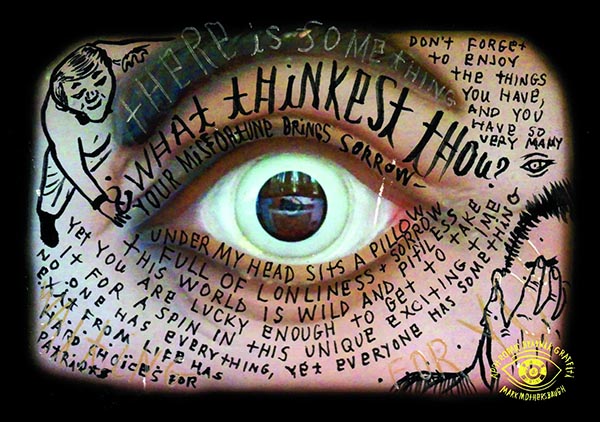
It’s merely a collection of thoughts and ideas from one human’s perspective of the world around him. And, maybe. Maybe some of the eyes are reaching out to you in an attempt to protect you from the evil that floats around you …?
If this sounds intriguing, pick it up here. A steal at $60.
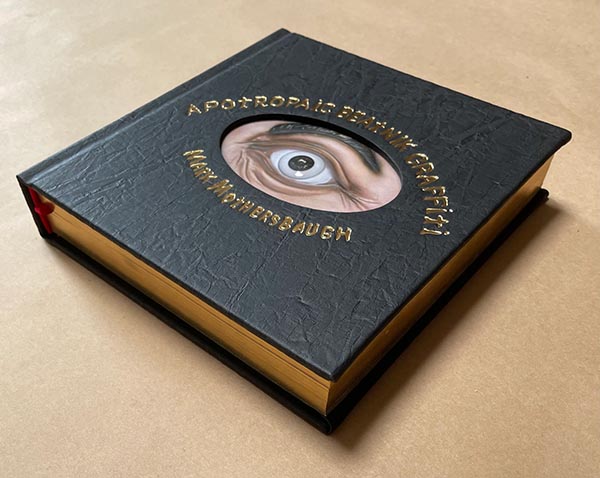
Word Up
Sometimes we wonder if we need to leave the Around the Web Bunker more often. The Oxford English Dictionary has recently announced its latest update, which includes more than two dozen new words, almost all of which we have never heard of. Says The Guardian:
Katsu, donburi and onigiri are among 23 Japanese words added to the Oxford English Dictionary in its latest update.
More than half of the borrowed words relate to food or cooking. Santoku, a knife with a short, flat blade that curves down at the tip, and okonomiyaki, a type of savoury pancake, were both added. Okonomiyaki is derived from okonomi, meaning “what you like”, combined with yaki, meaning “to fry, to sear”.
Maybe we need to watch the remake of Shogun? Art-related terms were also among the new dictionary recruits.
Kintsugi, the Japanese art of repairing broken pottery by joining pieces back together and filling cracks with lacquer dusted with powdered gold, silver, or platinum, highlighting the flaws in the mended object, was added.
You know, every day we are repairing broken pottery with gold, silver, or platinum, lacquer and we always wondered if there was a word for what we were doing. Now we know!
OED editors worked with researchers from the Tokyo University of Foreign Studies on the new batch of Japanese words. Non-Japanese words added in this quarter’s update include Bible-bashing, ultra-processed, and bibliophilia.
Kind of a letdown, really.
The Color of Monet
In April, 1874, an art exhibition was staged by the Société anonyme des artistes peintres, sculpteurs, graveurs, etc., a group of 19th-century artists who had been rejected by the Paris Salon, the arbiters and tastemakers of art back in the day. These revolutionaires included Claude Monet, Pierre-Auguste Renoir, Edgar Degas, and Paul Cézanne, among others. A snarky review by art critic Louis Leroy in Le Charivari was titled “The Exhibition of the Impressionists”—and the name, which was really an insult, stuck. And thus began the Impressionist movement. Next month marks the 150th anniversary of The First Impressionist Exhibition, as it has come to be known, and the Normandie Impressioniste 2024 festival is celebrating the occasion with a variety of events in Deauville, Caen, and many more across the region, as it was the French coastline that inspired some of the most famous works of the Impressionists. Says The Guardian:
Claude Monet was a regular visitor here in the late 19th century and painted this dramatic coast just north of Le Havre over 100 times, precisely because these capricious weather conditions added so much atmosphere to his work. But while Monet and the rest of the impressionists were famous for their ethereal depictions of outdoor life here and in the genteel Normandy countryside, their work was seen together for the first time, 150 years ago, inside a Paris photography studio.
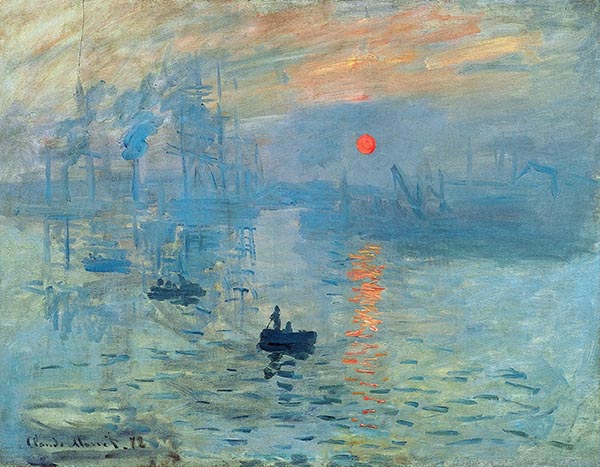
One of the works on display in 1874 was Monet’s Impression, Sunrise, a hazy loosely brushed depiction of the industrial port of Le Havre with a red morning sun reflecting on the water. Painted in 1872, it’s considered the first impressionist painting.
Indeed, it was the work singled out by Leroy for his snotty comments. “Impression, I was certain of it. A preliminary drawing for a wallpaper pattern is more finished than this seascape.” Le meow.
The festival kicked off on March 22 and runs through September 22. If you’re looking for something to do in Europe post-drupa, you could do worse than the coast of northern France.
Don’t Touch That Dial!
In the graphic communications industry, we know all about good and bad design, and while bad design can have negative consequences (poor signage gets someone lost or sent off in a dangerous direction, poor pharmaceutical package design could inadvertently misconstrue the proper use of a medication, etc.), most of the time, bad graphic design is just ugly. Likewise, bad industrial design can have negative consequences, as an ice cream shop in Somerville, Mass., recently found out.
Via Core 77, Aaron Cohen, the owner of Gracie's Ice Cream, posted a photo of a temperature dial to the shop’s Instagram, asking:
Imagine you own an ice cream shop and the thermostat on your dipping cabinet, which is the freezer ice cream is dipped (scooped) out of, is set to 4, which is too warm, and you want to make the freezer colder. Are you setting this dial to 3 or to 5 to make the freezer colder?

So: do you turn the dial in this direction of the arrow to make it colder or does the arrow point in the direction of colder numbers? Don’t we usually associate higher numbers with higher temperatures? And, by the way, how do you even tell what it is actually set at, as there appears to be no indicator? (It looks like someone manually drew an indicator next to the dial.) This is just bad design—and if you own an ice cream store, it could be a costly one if you move the dial in the wrong direction and ruin a batch.
I think this could've been solved a million different ways. A blue-to-red gradient would’ve been elegant, but perhaps too pricey to manufacture (two colors rather than one). Use of icons like snowflakes or ice cubes, one on one end, three on the other. Or even just placing the words “cold” on one end and “colder” on the other.
Makes you scream, we all scream…
Watch This
It has been interesting to see how Apple first helped kill off the market for wristwatches (everyone started just using their phones to see what time it was) and then created a whole new one with the Apple Watch. That said, people might like to have a wearable timepiece, but in some cases, the wrist is a poor location for one. For example, in manufacturing plants, a wristwatch could be a safety hazard. So, via Core 77, there are several new options for non-wrist-based watches.
Designed for "people who live or work in environments where they don't want something on their wrist [but] still want immediate access to the time," these Clip Watches are by the Ohio-based Dakota Watch Company.
They might not appeal to office dwellers, but for someone working in manufacturing, where wearing a wristwatch might be a safety no-no, they make sense. For that environment, the Cage Clip line comes with a protective aluminum cage that can be screwed on.

They also offer an Ana Digi Miniclip model targeted at outdoorsy types, which also has a compass.
If we were looking for a non-wrist-based timepiece, because we’re old-school (or just old), we’d opt for a good, old-fashioned pocketwatch.
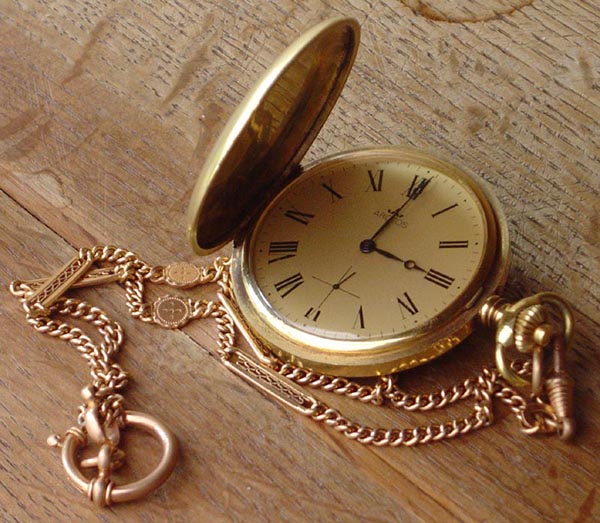
Cool Streets
Want to hang out on the “coolest street in the world,” as determined by Time Out magazine? No, nor do we, but if you did, hop a Qantas flight down under to High Street in Melbourne and check it out. What makes it so cool?
It’s a strip where vintage stores and cool cafés sit comfortably alongside a food truck park and boutique indie cinema. We hate to be clichéd and say there’s something for everyone on High Street, but in this case it’s true.
If you don’t want to coolest street, but would happily settle for number two, head over to Hollywood Road in Hong Kong.
Hollywood Road does it all: it’s a treasure trove of antiques, a culinary hotspot home to the city’s best bars and restaurants, and a hub for the arts, with murals, installations and galleries around every corner.
To answer what may very well be your first question, there is only one US street in the Top 10: East Eleventh in Austin, Tex.
East Eleventh earns its beloved status among locals by packing every square inch with incredible food, excellent coffee, a historic venue, and a backyard stage that evokes the bespoke approach Austinites take to keep the city’s soul alive.
Other US destinations in the Top 30: Fifth Avenue in Park Slope, Brooklyn (really?); East 3rd Street, Los Angeles; 18th Street, Chicago; and Miracle Mile, Miami.
Alas, nothing in Düsseldorf made the list.
Taste Graphene’s Steel
Was it a good week for graphene news? It’s always a good week for graphene news! Graphene-coated steel infrastructure goes in for testing. From (who else?) Graphene-Info:
Sparc Technologies and the South Australian Department for Infrastructure and Transport (DIT) have announced they will be trialing the Company’s ecosparc graphene enhanced coatings on steel infrastructure such as bridges and jetties in Australia.
The graphene coating is intended as an anti-corrosive agent.
The trial locations in highly corrosive coastal environments are considered ideal pieces of infrastructure for the first field trials of ecosparc.
The Most Dangerous Game
Well, this is a thought that’s going to fester. From Live Science: “AI drone that could hunt and kill people built in just hours by scientist ‘for a game.’” We’re guessing the game is not Scrabble.
Luis Wenus, an entrepreneur and engineer, incorporated an artificial intelligence (AI) system into a small drone to chase people around "as a game," he wrote in a post on March 2 on X, formerly known as Twitter. But he soon realized it could easily be configured to contain an explosive payload.
Collaborating with Robert Lukoszko, another engineer, he configured the drone to use an object-detection model to find people and fly toward them at full speed, he said. The engineers also built facial recognition into the drone, which works at a range of up to 33 feet (10 meters). This means a weaponized version of the drone could be used to attack a specific person or set of targets.
Like we don’t have enough to worry about.
“This literally took just a few hours to build, and made me realize how scary it is,” Wenus wrote. “You could easily strap a small amount of explosives on these and let 100's of them fly around. We check for bombs and guns but THERE ARE NO ANTI-DRONE SYSTEMS FOR BIG EVENTS & PUBLIC SPACES YET.”
Empire of the Ants
Here’s a phrase that we guarantee will elicit more than a few “ewws”: edible ants. It’s interesting that the thought of eating insects is revolting to most of us, at least in contemporary US culture, and yet we willing gorge ourselves at Red Lobster’s “Endless Shrimp” special or, indeed, on its eponymous crustacean. Weird, innit? But, via Ars Technica, some researchers are trying to expand our palate for arthropods.
Edible insects, like ants, are considered a delicacy in many cultures, as well as being very nutritious and an environmentally sustainable source of protein. But many of us have a longstanding aversion to consuming insects. In hopes of changing that aversion, chemists at San Diego State University (SDSU) have analyzed the flavor profiles of different ant species and found that not all edible ants taste alike, according to their presentation at a meeting of the American Chemical Society in New Orleans.
We’re not certain that knowing that different ants taste different helps all that much.
If you’re easily grossed out, you may want to scroll away:
Indeed, certain Ars staffers have eaten various kinds of bugs and actually found a few that were palatable. For example, dried scorpions worked well as a salty garnish on crab cakes, while tempura tarantula proved surprisingly tasty. Powdered-cricket-based flour was OK in chips and cheese puffs, but in holiday muffins? Not so much.
On the plus side, “tempura tarantula” did save us a little bit of work in the title of this AtW post.
Several years ago, French chef David Faure created an insect-based tasting menu at Aphrodite, his Michelin-starred restaurant in Nice. Adventurous diners could sample "crickets in a whiskey bubble with cubes of French toast and pears" or "squares of peas, carrot foam, and mealworms." The Michelin critics didn't share his enthusiasm for insect haute cuisine and took away his Michelin star in 2014. Aphrodite closed its doors for good in 2016.
And so the battle to make insects and arachnids palatable will continue.
Liu next hopes to analyze more ant species to determine their flavor profiles, as well as ant eggs and male ants (drones). Different processing methods might also affect the flavor profiles, so that, too, is something for further exploration.
OK, lunch time…or, maybe not…
Chips Ahoy!
If there is any brand that could legitimately produce an eclipse tie-in product, it would be SunChips. And, indeed, that is exactly what they are doing. Says Food & Wine:
The special edition cosmic chip offers two flavors in one bag, a new mash-up that echoes the sun and moon in synchronicity. SunChips Solar Eclipse Limited-Edition Pineapple Habanero and Black Bean Spicy Gouda chips are created to mirror bright sunny skies and the cheesy moon. The chips are packaged in a limited edition 2024 bag that may be a social media trophy to those who can acquire the exclusive snack.
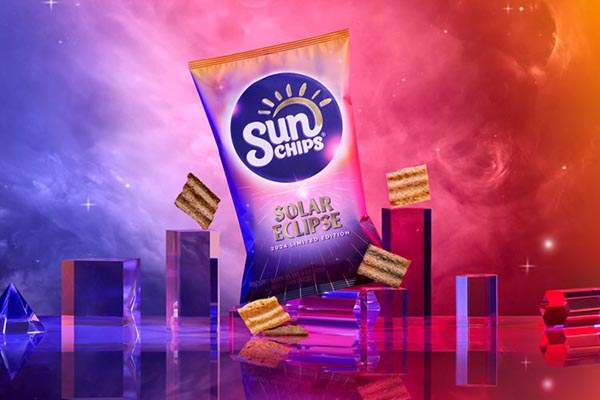
Speaking of Food & Wine, they published a restaurant recommendation guide for eclipse tourists heading to Upstate New York, and while we can’t speak for Buffalo or Rochester, we are disappointed that the best they could come up with for Syracuse was Pastabilities and a hot dog place. Really? Sure, Pastabilities is in the top tier of Italian restaurants, but there are many excellent eateries and drinkeries in Syracuse and its environs. Someone didn’t do their homework.
This Week in Printing, Publishing, and Media History
March 25
1811: Percy Bysshe Shelley is expelled from the University of Oxford for publishing the pamphlet The Necessity of Atheism.
1881: Hungarian pianist and composer Béla Bartók born.
1925: American short story writer and novelist Flannery O’Connor born.
1931: American journalist and activist Ida B. Wells dies (b. 1862).
1939: American screenwriter and producer D. C. Fontana born.
1957: United States Customs seizes copies of Allen Ginsberg’s poem “Howl” on obscenity grounds.
1995: WikiWikiWeb, the world's first wiki, and part of the Portland Pattern Repository, is made public by Ward Cunningham.
March 26
1484: William Caxton prints his translation of Aesop’s Fables.
1812: A political cartoon in the Boston Gazette coins the term “gerrymander” to describe oddly shaped electoral districts designed to help incumbents win reelection.
1827: German pianist and composer Ludwig van Beethoven dies (b. 1770).
1830: The Book of Mormon is published in Palmyra, N.Y.
1859: English poet and scholar A. E. Housman born.
1874: American poet and playwright Robert Frost born.
1892: American poet, essayist, and journalist Walt Whitman dies (b. 1819).
1911: American playwright, and poet Tennessee Williams born.
1931: American actor Leonard Nimoy born.
1959: American crime novelist and screenwriter Raymond Chandler dies (b. 1888).
1969: American novelist John Kennedy Toole dies (b. 1937).
1973: English playwright, actor, and composer Noël Coward dies (b. 1899).
1980: French linguist and critic Roland Barthes dies (b. 1915).
1996: American engineer and businessman, co-founder of Hewlett-Packard David Packard dies (b. 1912).
March 27
1845: German physicist, academic, and Nobel Prize laureate Wilhelm Röntgen born.
1869: American publisher and politician, and 65th Mayor of New York City James Harper dies (b. 1795).
1931: English author and playwright Arnold Bennett dies (b. 1867).
2006: Ukrainian-Polish author Stanis?aw Lem dies (b. 1921).
2012: American poet essayist and feminist Adrienne Rich dies (b. 1929).
March 28
1836: German-American brewer and founder of the Pabst Brewing Company Frederick Pabst born. (Did they sponsor the hipster Olympics?)
1842: First concert of the Vienna Philharmonic Orchestra, conducted by Otto Nicolai.
1868: Russian novelist, short story writer, and playwright Maxim Gorky born.
1994: How absurd: Romanian-French playwright and critic Eugène Ionesco dies (b. 1909).
March 29
1871: Royal Albert Hall is opened by Queen Victoria.
1886: John Pemberton brews the first batch of Coca-Cola in a backyard in Atlanta.
1943: English actor and comedian Eric Idle born, looking on the bright side of life.
1999: The Dow Jones Industrial Average closes above the 10,000 mark (10,006.78) for the first time, during the height of the dot-com bubble.
March 30
1853: Dutch-French painter and illustrator Vincent van Gogh born.
1880: Irish dramatist, playwright, and memoirist Seán O'Casey born.
1986: American poet and etymologist John Ciardi dies (b. 1916).
2004: English-American journalist and author Alistair Cooke dies (b. 1908).
March 31
1596: French mathematician and philosopher René Descartes born. (Apparently he thought.)
1631: English lawyer and poet John Donne dies (b. 1572).
1685: German organist and composer Johann Sebastian Bach born.
1732: Austrian pianist and composer Joseph Haydn born.
1809: Ukrainian-Russian short story writer, novelist, and playwright Nikolai Gogol born.
1855: English novelist and poet Charlotte Brontë dies (b. 1816).
1889: The Eiffel Tower is officially opened. (Not everyone in France was a fan; author Guy de Maupassant ate lunch every day at the tower’s base restaurant, because, he said, “inside the restaurant was one of the few places where I could sit and not actually see the Tower!”)
1906: The Intercollegiate Athletic Association of the United States (later the National Collegiate Athletic Association) is established to set rules for college sports in the United States. (Before that it was all just madness...)
1918: Daylight saving time goes into effect in the United States for the first time and, unfortunately, not the last.
1930: The Motion Picture Production Code is instituted, imposing strict guidelines on the treatment of sex, crime, religion and violence in film, in the U.S., for the next 38 years.
1951: Remington Rand delivers the first UNIVAC I computer to the United States Census Bureau.
2016: Scottish comedian, actor and screenwriter Ronnie Corbett dies (b. 1930).















Discussion
Only verified members can comment.